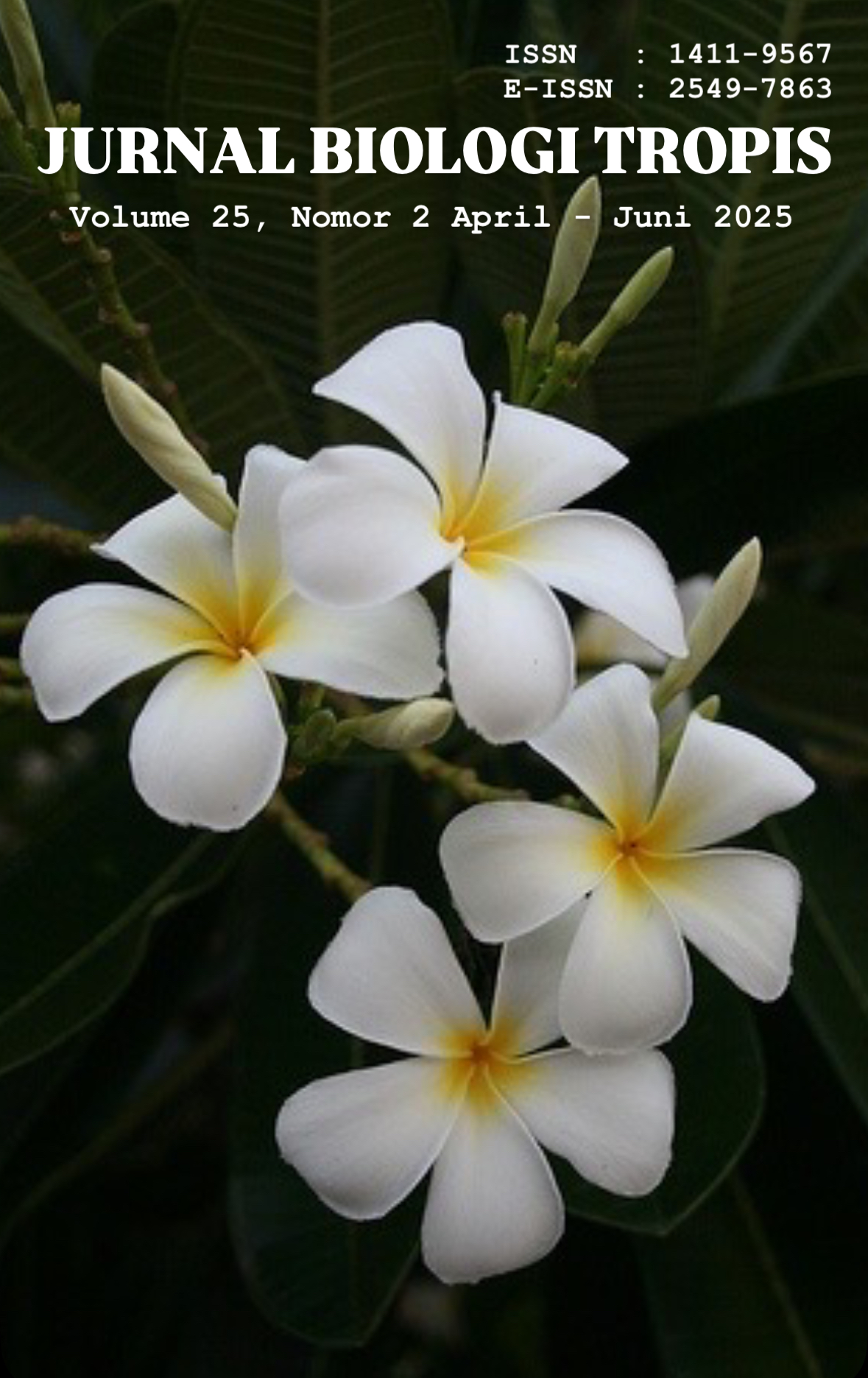Isolation Endophyte Bacteria from Keladi Merah (Caladium bicolor L.) as Activity Potential Antimicroba
Authors
Anggraini Putri Utami , Yuyun Nisaul Khairillah , Nur Jati Jagad , Galih Dwiki RamandaDOI:
10.29303/jbt.v25i2.8814Published:
2025-04-22Issue:
Vol. 25 No. 2 (2025): April-JuniKeywords:
Antimicrobial, Caladium bicolor L., endophytic bacteria, Staphylococcus aureus.Articles
Downloads
How to Cite
Downloads
Metrics
Abstract
Since endophytic bacteria are known to generate bioactive substances with possible antibacterial qualities, they present a viable substitute for antibiotics in the fight against antibiotic resistance, especially in harmful bacteria like Staphylococcus aureus. This study aimed to isolate and identify potential endophytic bacteria from red caladium plants (Caladium bicolor L.) and evaluate their antimicrobial activity against S. aureus, a Gram-positive bacterium notorious for its antibiotic resistance. The research was conducted using the disc diffusion method to assess the inhibitory effects of endophytic bacterial isolates on S. aureus growth. The results revealed varying levels of antimicrobial activity among the isolates, with isolate CLB242 demonstrating an average inhibition zone of 16.33 mm, isolate CLB244 showing an average of 17.6 mm, and isolate CLB245 showed an inhibition zone of 4 mm. Meanwhile, other isolates did not produce any inhibition zones, suggesting possible resistance or undetectable active compounds. Certain endophytic bacterial isolates from Caladium bicolor L. exhibit promising antimicrobial activity against S. aureus, highlighting their potential as sources of novel antimicrobial agents. Further research is recommended to identification of the active isolates molecular profiles and characterization of their bioactive compounds responsible for the observed antimicrobial effects, as well as to explore their mechanisms of action and potential applications in pharmaceutical development.
References
Anania, A., Mukarlina, & Linda, R. (2017). Pertumbuhan dan Kandungan Pigmen Tanaman Keladi (Caladium bicolor Aiton Vent) pada Tanah yang Merkuri (HgCl2). Jurnal Protobiont , 6(3), 215–221. https://doi.org/10.26418/protobiont.v6i3
Arinda, Y., Fitriana, N., Arfiana, V., Fatimah, N., & Shabrina, A. (2019). Aktivitas Anti Bakteri Daun Sirih : Uji Ekstrak KHM ( Kadar Hambat Minimum ) dan KBM ( Kadar Bakterisidal Minimum ). 16(2), 101–108. doi:10.30595/st.v16i2.7126
Balouiri, M., Sadiki, M., & Ibnsouda, S. K. (2016). Methods for in vitro evaluating antimicrobial activity : A review $. Journal of Pharmaceutical Analysis, 6(2), 71–79. https://doi.org/10.1016/j.jpha.2015.11.005
Compant, S., Samad, A., Faist, H., & Sessitsch, A. (2019). A review on the plant microbiome: Ecology, functions, and emerging trends in microbial application. Journal of Advanced Research, 19, 29–37. https://doi.org/10.1016/j.jare.2019.03.004
El-Deeb, B., Fayez, K & Gherbawy, Y. (2013) ‘Isolation and characterization of endophytic bacteria from Plectranthus tenuiflorus medicinal plant in Saudi Arabia desert and their antimicrobial activities’, Journal of Plant Interactions, 8(1), pp. 56–64. doi: 10.1080/17429145.2012.680077.
Essien, E. E., Jacob, I. E., & Thomas, P. S. (2015). Phytochemical Composition, Antimicrobial and Antioxidant Activities of Leaves and Tubers of Three Caladium Species. International Journal of Medicinal Plants and Natural Products, 1(2), 24–30. https://doi.org/10.32807/jkp.v11i2.6.
Jufri, R. F. (2020). Microbial Isolation. Journal La Lifesci, 1(1), 18–23. https://doi.org/10.37899/journallalifesci.v1i1.33
Kearns, D. B. (2010). A field guide to bacterial swarming motility. Nature Reviews Microbiology, 8(9), 634–644. https://doi.org/10.1038/nrmicro2405
Lugtenberg, B. J. J., Malfanova, N., Kamilova, F., & Berg, G. (2013). Plant Growth Promotion by Microbes. Molecular Microbial Ecology of the Rhizosphere: Volume 1, 1(January 2018), 561–573. https://doi.org/10.1002/9781118297674.ch53
Munita, J. M., & Arias, C. A. (2016). Mechanisms of antibiotic resistance. Virulence Mechanisms of Bacterial Pathogens, 6, 481–511. https://doi.org/10.1128/9781555819286.ch17
Nair, D. N & Padmavathy, S. (2014) ‘Impact of Endophytic Microorganisms on Plants , Environment and Humans’, 2014. doi: 10.1155/2014/250693.
Paray, A. A., Singh, M., & Amin Mir, M. (2023). Gram Staining: A Brief Review. International Journal of Research and Review, 10(9), 336–341. https://doi.org/10.52403/ijrr.20230934
Rosenblueth, M & Martínez-Romero, E. (2006) ‘Bacterial endophytes and their interactions with hosts’, Molecular Plant-Microbe Interactions, 19(8), pp. 827–837. doi: 10.1094/MPMI-19-0827.
Seko, M., Sabuna, A. C., & Ngginak, J. (2021). AJERAN LEAVES ETHANOL EXTRACT (Bidens pilosa L) AS AN ANTIBACTERIAL Staphylococcus aureus. Jurnal Biosains, 7(1), 1. https://doi.org/10.24114/jbio.v7i1.22671
Sessitsch, A., Reiter, B., & Berg, G. (2004). Endophytic bacterial communities of field-grown potato plants and their plant-growth-promoting and antagonistic abilities. Canadian Journal of Microbiology, 50(4), 239–249. https://doi.org/10.1139/w03-118
Siddiquee, S. (2017). The Basic Concept of Microbiology. In Practical Handbook of the Biology and Molecular Diversity of Trichoderma Species from Tropical Regions (pp. 1–15). https://doi.org/10.1007/978-3-319-64946-7_1.
Simarmata, R., Lekatompessy, S., Bioteknologi, P. P., & Pengetahuan, L. I. (2007). Isolasi Mikroba Endofitik dari Tanaman Obat Sambung Nyawa Gynura Procumbens) dan Analisis Potensinya. Berk. Penel. Hayati: 13 (85–90). doi 10.23869/331
Singh, M., Kumar, A., Singh, R., & Pandey, K. D. (2017). Endophytic bacteria: a new source of bioactive compounds. 3 Biotech, 7(5), 1–14. https://doi.org/10.1007/s13205-017-0942-z
Sukiman, H. & Nuriyanah, D. (2016) ‘Potensi Bakteri Endofitik dari Tanaman Keladi Tikus sebagai Penghasil Zat Antimikroba dan Antioksidan.’, Paspalum: Jurnal Ilmiah Pertanian, 7(1), pp. 27–34. doi: 10.36974/jbi.v7i1.833
Sun, L., Qiu, F., Zhang, X., Dai, X., Dong, X., & Song, W. (2008). Endophytic Bacterial Diversity in Rice (Oryza sativa L.) Roots Estimated by 16S rDNA Sequence Analysis. Microbial Ecology, 55(3), 415–424. doi: 10.1007/s00248-007-9287-1
Swift, J. F., Migicovsky, Z., Trello, G. E., & Miller, A. J. (2023). Grapevine bacterial communities display compartment-specific dynamics over space and time within the Central Valley of California. Environmental Microbiome, 18(1), 1–18. https://doi.org/10.1186/s40793-023-00539-0
Tacconelli, E., Carrara, E., Savoldi, A., Harbarth, S., Mendelson, M., Monnet, D. L., Pulcini, C., Kahlmeter, G., Kluytmans, J., Carmeli, Y., Ouellette, M., Outterson, K., Patel, J., Cavaleri, M., Cox, E. M., Houchens, C. R., Grayson, M. L., Hansen, P., Singh, N., … Zorzet, A. (2018). Discovery, research, and development of new antibiotics: the WHO priority list of antibiotic-resistant bacteria and tuberculosis. The Lancet Infectious Diseases, 18(3), 318–327. https://doi.org/10.1016/S1473-3099(17)30753-3
Uche, F., Onuchukwu, D., Ibezim, C., & Ogbu, H. (2019). Methanolic extract of Caladium bicolor leaves against selected clinical isolates. GSC Biological and Pharmaceutical Sciences, 6, 98–107. https://doi.org/10.30574/gscbps.2019.6.2.0022
Vaou, N. et al. (2021) ‘Towards advances in medicinal plant antimicrobial activity: A review study on challenges and future perspectives’, Microorganisms, 9(10), pp. 1–28. doi: 10.3390/microorganisms9102041.
Worku, S., Abebe, T., Seyoum, B., Alemu, A., Shimelash, Y., Yimer, M., Abdissa, A., Beyene, G. T., Swedberg, G., & Mihret, A. (2023). Molecular Epidemiology of Methicillin-Resistant Staphylococcus aureus among Patients Diagnosed with Surgical Site Infection at Four Hospitals in Ethiopia. Antibiotics, 12(12). https://doi.org/10.3390/antibiotics12121681.
Ye, S., Peng, B. and Liu, T. (2022) ‘Effects of organic fertilizers on growth characteristics and fruit quality in Pear-jujube in the Loess Plateau’, Scientific Reports, 12(1), pp. 1–11. doi: 10.1038/s41598-022-17342-5.
Young, K. D. (2007). Bacterial morphology: Why have different shapes? Current Opinion in Microbiology, 10(6), 596–600. doi: /10.1016/j.mib.2007.09.009
License
Copyright (c) 2025 Anggraini Putri Utami, Yuyun Nisaul Khairillah, Nur Jati Jagad, Galih Dwiki Ramanda

This work is licensed under a Creative Commons Attribution 4.0 International License.

Jurnal Biologi Tropis is licensed under a Creative Commons Attribution 4.0 International License.
The copyright of the received article shall be assigned to the author as the owner of the paper. The intended copyright includes the right to publish the article in various forms (including reprints). The journal maintains the publishing rights to the published articles.
Authors are permitted to disseminate published articles by sharing the link/DOI of the article at the journal. Authors are allowed to use their articles for any legal purposes deemed necessary without written permission from the journal with an acknowledgment of initial publication to this journal.


























